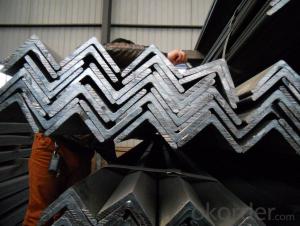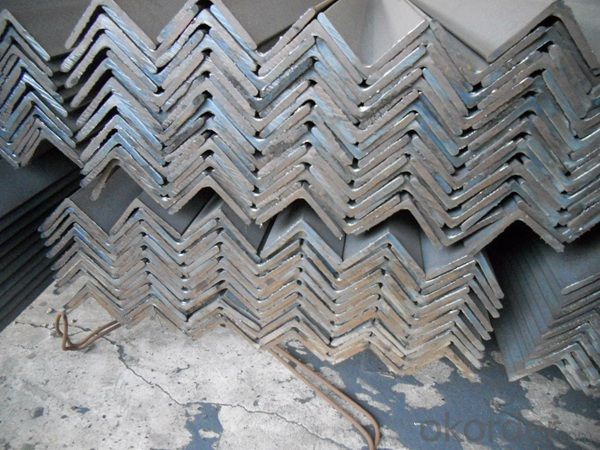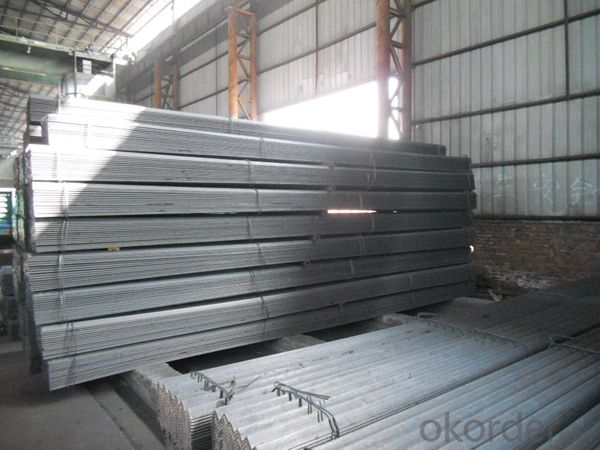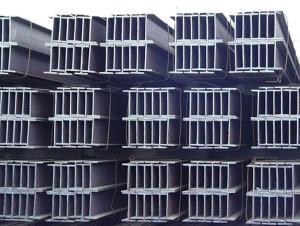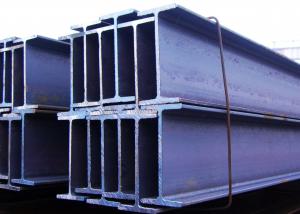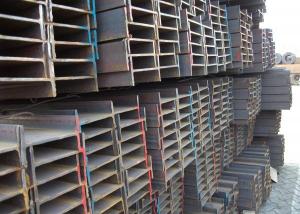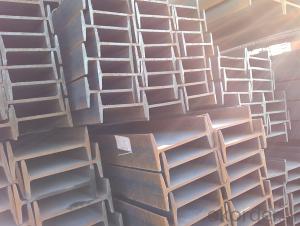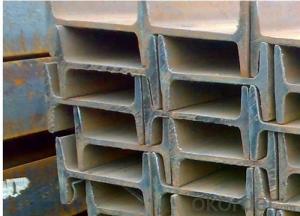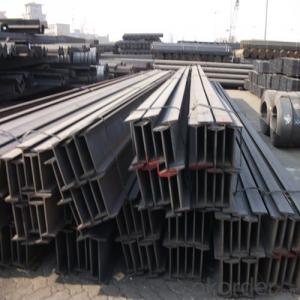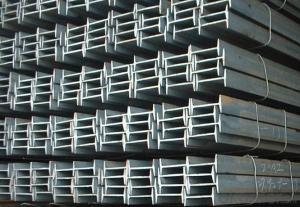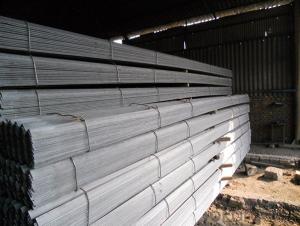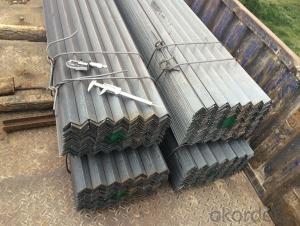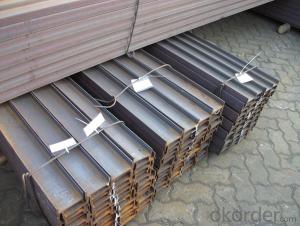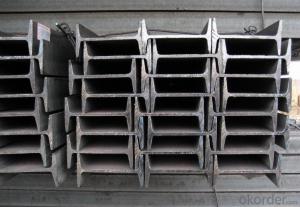High Quality Hot Rolled Equal Angle Steel Bars for Strcuture
- Loading Port:
- Tianjin
- Payment Terms:
- TT OR LC
- Min Order Qty:
- 25 m.t.
- Supply Capability:
- 200000 m.t./month
OKorder Service Pledge
OKorder Financial Service
You Might Also Like
Product Description:
OKorder is offering high quality High Quality Hot Rolled Equal Angle Steel Bars for Strcuture at great prices with worldwide shipping. Our supplier is a world-class manufacturer of steel, with our products utilized the world over. OKorder annually supplies products to European, North American and Asian markets. We provide quotations within 24 hours of receiving an inquiry and guarantee competitive prices.
Product Applications:
High Quality Hot Rolled Equal Angle Steel Bars for Strcuture are ideal for structural applications and are widely used in the construction of buildings and bridges, and the manufacturing, petrochemical, and transportation industries.
1. Supporting members, most commonly in the house raising industry to strengthen timber bears under houses. Transmission line towers, etc
2. Prefabricated structure
3. Medium scale bridges
4. It is widely used in various building structures and engineering structures such as roof beams, bridges, transmission towers, hoisting machinery and transport machinery, ships, industrial furnaces, reaction tower, container frame and warehouse etc.
Product Advantages:
High Quality Hot Rolled Equal Angle Steel Bars for Constrcution are durable, strong, and resist corrosion.
Main Product Features:
· Premium quality
· Prompt delivery & seaworthy packing (30 days after receiving deposit)
· Corrosion resistance
· Can be recycled and reused
· Mill test certification
· Professional Service
· Competitive pricing
Product Specifications:
1. Invoicing on theoretical weight or actual weight as customer request
2. Standard: EN10025, GB Standard, ASTM
3. Grade: Q235B, Q345B, SS400, ASTM A36, S235JR, S275JR
4.Sizes:
EQUAL ANGLES SIZES | |||
a(mm) | a1(mm) | thickness(mm) | length |
25 | 25 | 2.5---3.0 | 6M/12M |
30 | 30 | 2.5---4.0 | 6M/12M |
38 | 38 | 2.5 | 6M/12M |
38 | 38 | 3.0---5.0 | 6M/12M |
40 | 40 | 3.0---6.0 | 6M/12M |
50 | 50 | 3 | 6M/12M |
50 | 50 | 3.7---6.0 | 6M/9M/12M |
60 | 60 | 5.0---6.0 | 6M/9M/12M |
63 | 63 | 6.0---8.0 | 6M/9M/12M |
65 | 65 | 5.0---8.0 | 6M/9M/12M |
70 | 70 | 6.0---7.0 | 6M/9M/12M |
75 | 75 | 5.0---10.0 | 6M/9M/12M |
80 | 80 | 6.0---10.0 | 6M/9M/12M |
90 | 90 | 6.0---10.0 | 6M/9M/12M |
100 | 100 | 6.0---12.0 | 6M/9M/12M |
120 | 120 | 8.0-12.0 | 6M/9M/12M |
125 | 125 | 8.0---12.0 | 6M/9M/12M |
130 | 130 | 9.0-12.0 | 6M/9M/12M |
140 | 140 | 10.0-16.0 | 6M/9M/12M |
150 | 150 | 10---15 | 6M/9M/12M |
160 | 160 | 10---16 | 6M/9M/12M |
180 | 180 | 12---18 | 6M/9M/12M |
200 | 200 | 14---20 | 6M/9M/12M |
5. Material details:
Alloy No | Grade | Element (%) | |||||
C | Mn | S | P | Si | |||
Q235 | B | 0.12—0.20 | 0.3—0.7 | ≤0.045 | ≤0.045 | ≤0.3 | |
Alloy No | Grade | Yielding strength point( Mpa) | |||||
Thickness (mm) | |||||||
≤16 | >16--40 | >40--60 | >60--100 | ||||
≥ | |||||||
Q235 | B | 235 | 225 | 215 | 205 | ||
Alloy No | Grade | Tensile strength (Mpa) | Elongation after fracture (%) | ||||
Thickness (mm) | |||||||
≤16 | >16--40 | >40--60 | >60--100 | ||||
≥ | |||||||
Q235 | B | 375--500 | 26 | 25 | 24 | 23 | |
FAQ:
Q1: Why buy Materials & Equipment from OKorder.com?
A1: All products offered byOKorder.com are carefully selected from China's most reliable manufacturing enterprises. Through its ISO certifications, OKorder.com adheres to the highest standards and a commitment to supply chain safety and customer satisfaction.
Q2: How do we guarantee the quality of our products?
A2: We have established an advanced quality management system which conducts strict quality tests at every step, from raw materials to the final product. At the same time, we provide extensive follow-up service assurances as required.
Q3: How soon can we receive the product after purchase?
A3: Within three days of placing an order, we will begin production. The specific shipping date is dependent upon international and government factors, but is typically 7 to 10 workdays.
Q4: What makes stainless steel stainless?
A4: Stainless steel must contain at least 10.5 % chromium. It is this element that reacts with the oxygen in the air to form a complex chrome-oxide surface layer that is invisible but strong enough to prevent further oxygen from "staining" (rusting) the surface. Higher levels of chromium and the addition of other alloying elements such as nickel and molybdenum enhance this surface layer and improve the corrosion resistance of the stainless material.
Q5: Can stainless steel rust?
A5: Stainless does not "rust" as you think of regular steel rusting with a red oxide on the surface that flakes off. If you see red rust it is probably due to some iron particles that have contaminated the surface of the stainless steel and it is these iron particles that are rusting. Look at the source of the rusting and see if you can remove it from the surface.
Images:
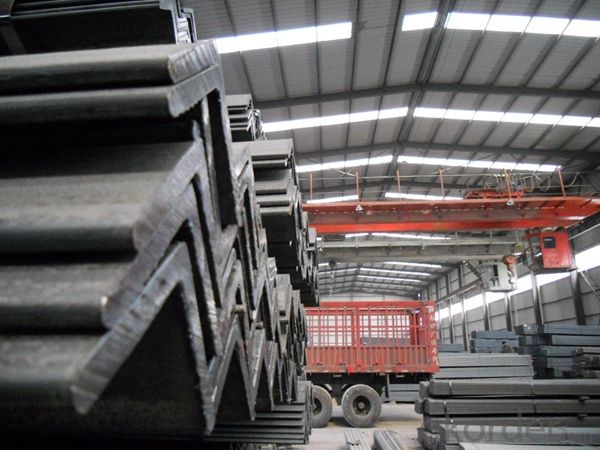
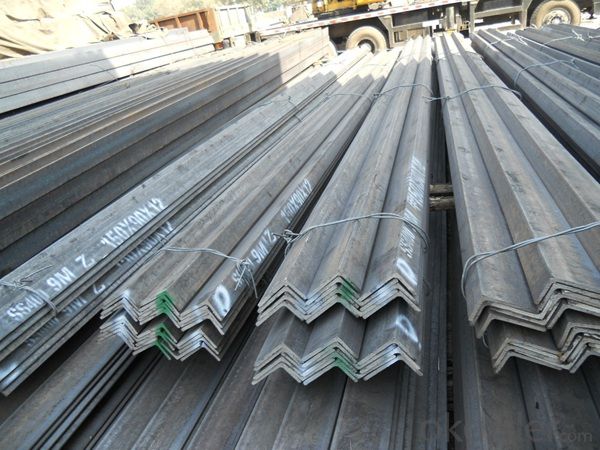
- Q: Can steel I-beams be used in the construction of airport terminals?
- Yes, steel I-beams can be used in the construction of airport terminals. Steel I-beams are commonly used in the construction industry due to their strength, durability, and ability to support heavy loads. They can provide the necessary structural support for large spans and open areas in airport terminals, making them a suitable choice for such constructions.
- Q: Can steel I-beams be custom fabricated?
- Certainly! Steel I-beams can indeed be custom fabricated. Custom fabrication of steel I-beams pertains to the manufacturing procedure of these structural components in accordance with precise design requisites, encompassing distinct measurements, lengths, and load-bearing capacities. This grants the opportunity for tailor-made solutions to address the specific requirements of diverse construction undertakings. The process of custom fabrication of steel I-beams entails cutting, welding, and molding the steel in order to attain the desired specifications. This task is typically executed by seasoned steel fabricators who possess the expertise, aptitude, and apparatus to undertake such ventures. The capability to custom fabricate steel I-beams is of utmost importance in numerous industries, including construction, engineering, and architecture, as it facilitates the establishment of structures that are both secure and efficient.
- Q: How do steel I-beams perform in high-traffic bridge applications?
- Due to their exceptional strength and durability, steel I-beams are an excellent option for high-traffic bridge applications. These beams are specifically engineered to withstand heavy loads and offer superior structural support, making them ideal for use in bridges experiencing high volumes of traffic. A key advantage of steel I-beams is their ability to carry heavy loads. They can withstand the weight of multiple vehicles simultaneously, ensuring the safety and stability of the bridge, even under extreme traffic conditions. Not only are steel I-beams strong, but they also possess long-term durability. They are highly resistant to corrosion, rust, and other environmental factors, enabling their use in various climates and locations. This durability ensures that the bridge remains structurally sound and can endure the wear and tear caused by continuous traffic flow. Moreover, the design of steel I-beams allows for efficient weight distribution, reducing the strain on the bridge structure. This efficient load distribution helps minimize deflection and deformation, guaranteeing the bridge's integrity over time. Another advantage of steel I-beams is their versatility in bridge construction. They can be easily fabricated and tailored to meet the specific requirements of each bridge project, including length, width, and height. This flexibility empowers engineers to design bridges that can accommodate different traffic conditions, ensuring optimal performance and safety. Overall, steel I-beams are a highly reliable and efficient choice for high-traffic bridge applications. Their strength, durability, and versatility make them the preferred option for engineers and architects when designing bridges capable of handling heavy traffic loads and providing long-lasting performance.
- Q: How do steel I-beams perform in terms of load distribution?
- Steel I-beams are known for their excellent load distribution capabilities. The shape of the I-beam is specifically designed to efficiently distribute the weight and force exerted on it. The flanges of the I-beam provide significant strength and stiffness, while the web connects the flanges, providing additional support. The I-beam's design allows it to evenly distribute the load across its length, effectively transferring the weight to the supporting structures such as columns or walls. This load distribution capability is crucial in various construction applications, including bridges, buildings, and industrial structures. Due to their efficient load distribution, steel I-beams can handle heavy loads and provide structural stability. They can resist bending, shearing, and deflection, ensuring the integrity and safety of the structure. The load distribution characteristics of steel I-beams make them ideal for spanning long distances and supporting significant weight. Moreover, steel I-beams can also be designed and manufactured to meet specific load requirements, allowing for customization based on the intended application. This flexibility ensures that the load distribution capabilities of steel I-beams can be optimized for various construction projects. In conclusion, steel I-beams are highly effective in terms of load distribution. Their unique shape and structural properties enable them to evenly distribute weight and force, making them a reliable choice for supporting heavy loads in construction projects.
- Q: Can steel I-beams be used in historical building restoration projects?
- Yes, steel I-beams can be used in historical building restoration projects. They are often utilized to reinforce and strengthen the structure, providing necessary support while preserving the original architectural elements. Steel I-beams can be carefully integrated into the restoration process, ensuring the historical integrity of the building is maintained while improving its structural stability.
- Q: Can steel I-beams be used for parking garages?
- Yes, steel I-beams can be used for parking garages. Steel I-beams are often preferred in the construction of parking garages due to their high strength and durability. They provide excellent load-bearing capabilities, allowing for the construction of large and multilevel parking structures. Additionally, steel I-beams offer flexibility in design, allowing for efficient use of space and ease of construction.
- Q: It's not clear what difference between I-beam and channel steel What's the difference between the formulas for the two materials?
- I-beam, also called steel girder, is a long strip steel with cross section. Wing to the edge of the root cause of I-beam thinning, have a certain angle,I type is Arabia digital cm with its waist high number to represent, web and flange thickness and flange width of different specifications to the waist high (H) * (b) * waist leg width thickness (T). The number of said, such as "160 x 88 x 6", that is 160 mm high waist, leg width is 88 mm, 6 mm thick steel waist. The specifications of I-beam can also be expressed by type. The model indicates the height of centimeters, such as 16#. The same as the waist high beam, there are several different leg width and waist thick, B C to make a difference in the model to the right a, such as 32a# 32b# 32c#. Ordinary I-beam and light steel I-beam, ordinary hot rolled I-beam specifications for 10-63#. Standard Specification for hot-rolled ordinary I-beam supplied by supply and demand agreement is 12-55#. I-beam is widely used in various building structures, bridges, vehicles, supports, machinery and so on.
- Q: How do steel I-beams perform in terms of electromagnetic interference (EMI) shielding?
- Despite their strength and durability, steel I-beams fall short in providing substantial protection against electromagnetic interference (EMI). This is due to the fact that steel, being a proficient conductor of electricity, has the tendency to amplify electromagnetic fields instead of impeding them. Consequently, steel I-beams do not prove effective in mitigating the impact of electromagnetic interference.
- Q: How do you calculate the shear force in a steel I-beam?
- To calculate the shear force in a steel I-beam, you need to determine the applied load or external forces acting on the beam. Once you know the magnitude and distribution of these forces, you can analyze the beam's cross-section to determine the shear force at any specific point. This involves considering the equilibrium of forces and moments acting on the beam, as well as understanding the shear flow and the properties of the beam's materials. Using these principles, you can calculate the shear force at different locations along the beam.
- Q: What are the factors that affect the weight of steel I-beams?
- The factors that affect the weight of steel I-beams include the length, size, and thickness of the beam, as well as the specific type and grade of steel used. Additionally, any additional features or modifications such as holes or cutouts can also impact the weight of the I-beam.
Send your message to us
High Quality Hot Rolled Equal Angle Steel Bars for Strcuture
- Loading Port:
- Tianjin
- Payment Terms:
- TT OR LC
- Min Order Qty:
- 25 m.t.
- Supply Capability:
- 200000 m.t./month
OKorder Service Pledge
OKorder Financial Service
Similar products
Hot products
Hot Searches
Related keywords
